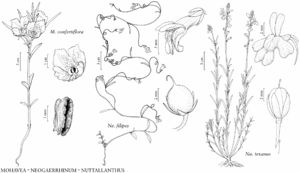Difference between revisions of "Nuttallanthus texanus"
Revis. Antirrhineae, 460. 1988.
FNA>Volume Importer |
FNA>Volume Importer |
||
| Line 65: | Line 65: | ||
|publication year=1988 | |publication year=1988 | ||
|special status=Weedy;Illustrated | |special status=Weedy;Illustrated | ||
| − | |source xml=https://jpend@bitbucket.org/aafc-mbb/fna-data-curation.git/src/ | + | |source xml=https://jpend@bitbucket.org/aafc-mbb/fna-data-curation.git/src/f50eec43f223ca0e34566be0b046453a0960e173/coarse_grained_fna_xml/V17/V17_132.xml |
|genus=Nuttallanthus | |genus=Nuttallanthus | ||
|species=Nuttallanthus texanus | |species=Nuttallanthus texanus | ||
Revision as of 20:04, 16 December 2019
Fertile stems 1–13(–30), distally branched, sometimes simple, 17–70 cm. Leaves: blades of sterile-stem leaves elliptic or oblong-elliptic to obovate, 2–18 × 0.5–3 mm, blades of fertile-stem leaves linear to narrowly elliptic, 7–34 × (0.5–)1–3.1 mm. Racemes (2–)4–20 cm; bracts narrowly oblanceolate or lanceolate to narrowly elliptic, (0.7–)2–4 mm. Pedicels erect, 2–8(–9) mm in fruit, glabrous or sparsely glandular-pubescent, hairs to 0.1 mm. Flowers: calyx lobes lanceolate to oblong, (2–)2.5–4.2 × 0.8–1.6 mm, proximally sparsely glandular-pubescent, sometimes glabrous; corolla blue to pale violet, (11–)14–22 mm, spurs curved, sometimes straight, 4.5–11 mm, abaxial lip 5–11 mm, adaxial 3–6 mm. Capsules oblong-ovoid, 2.6–4.8 × 2.5–4 mm. Seeds gray, 0.3–0.5 mm, edges rounded, rarely angled or irregularly dentate, faces prominently pointed-tuberculate, rarely with rounded ridges and scattered, rounded tubercles. 2n = 12, 24.
Phenology: Flowering Feb–Jul.
Habitat: Sandy prairies, woodlands, roadsides, fallow fields, rocky bluffs, disturbed sites.
Elevation: 0–1800 m.
Distribution
Alta., B.C., Sask., Ala., Ariz., Ark., Calif., Colo., Fla., Ga., Ill., Kans., Ky., La., Minn., Miss., Mo., Mont., Nebr., N.Mex., N.C., N.Dak., Okla., Oreg., S.C., S.Dak., Tenn., Tex., Utah, Va., Wash., Wyo., Mexico, South America, introduced in West Indies (Dominican Republic), Pacific Islands (Hawaii).
Discussion
Sutton observed that some specimens from the northwestern United States and southwestern Canada have seeds with dentate ridges, similar to those of the South American Nuttallanthus subandinus. Sutton did not explicitly associate the North American plants with that species, stating that further study was needed. Among specimens examined for this treatment were five from Kansas, Louisiana, and Oklahoma with dentate-ridged seeds apparently similar to those illustrated in Sutton’s monograph. In other features, these specimens most resemble N. texanus.
P. T. Crawford (2003) also reported two seed morphotypes in Nuttallanthus texanus. Among plants from California, Oklahoma, Texas, and the southeastern United States were individuals bearing seeds with ridges rounded and faces densely covered with acute tubercles. Among plants from Arkansas, Louisiana, Oklahoma, and Texas were individuals bearing seeds with more sharply angled ridges and faces with rounded ridges and scattered, rounded tubercles. From his description and photographs, this second type does not match the dentate-ridged seed type discussed above. Pending further study, plants with all three seed types are included here in N. texanus.
Selected References
None.
